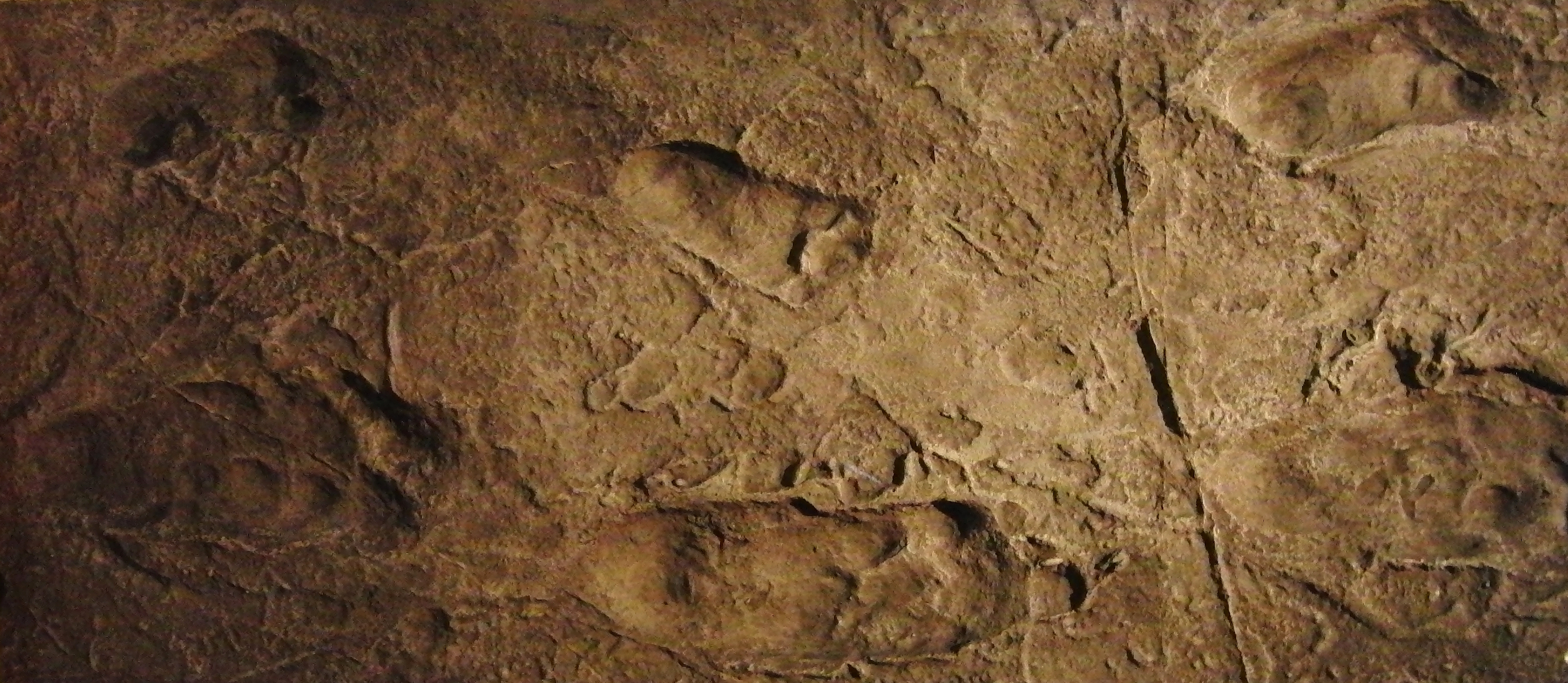|
Laetoli, Tanzania
Laetoli is a pre-historic site located in Enduleni ward of Ngorongoro District in Arusha Region, Tanzania. The site is dated to the Plio-Pleistocene and famous for its Hominina footprints, preserved in volcanic ash. The site of the Laetoli footprints (Site G) is located 45 km south of Olduvai gorge. The location and tracks were discovered by archaeologist Mary Leakey and her team in 1976, and were excavated by 1978. Based on analysis of the footfall impressions "The Laetoli Footprints" provided convincing evidence for the theory of bipedalism in Pliocene Hominina and received significant recognition by scientists and the public. Since 1998, paleontological expeditions have continued under the leadership of Amandus Kwekason of the National Museum of Tanzania and Terry Harrison of New York University, leading to the recovery of more than a dozen new Hominina finds, as well as a comprehensive reconstruction of the paleoecology. The site is a registered National His ... [...More Info...] [...Related Items...] OR: [Wikipedia] [Google] [Baidu] |
Hominidae
The Hominidae (), whose members are known as the great apes or hominids (), are a taxonomic family of primates that includes eight extant species in four genera: '' Pongo'' (the Bornean, Sumatran and Tapanuli orangutan); ''Gorilla'' (the eastern and western gorilla); '' Pan'' (the chimpanzee and the bonobo); and ''Homo'', of which only modern humans remain. Several revisions in classifying the great apes have caused the use of the term ''"hominid"'' to vary over time. The original meaning of "hominid" referred only to humans (''Homo'') and their closest extinct relatives. However, by the 1990s humans, apes, and their ancestors were considered to be "hominids". The earlier restrictive meaning has now been largely assumed by the term ''"hominin"'', which comprises all members of the human clade after the split from the chimpanzees (''Pan''). The current meaning of "hominid" includes all the great apes including humans. Usage still varies, however, and some scientists and la ... [...More Info...] [...Related Items...] OR: [Wikipedia] [Google] [Baidu] |
Springer Science & Business Media
Springer Science+Business Media, commonly known as Springer, is a German multinational publishing company of books, e-books and peer-reviewed journals in science, humanities, technical and medical (STM) publishing. Originally founded in 1842 in Berlin, it expanded internationally in the 1960s, and through mergers in the 1990s and a sale to venture capitalists it fused with Wolters Kluwer and eventually became part of Springer Nature in 2015. Springer has major offices in Berlin, Heidelberg, Dordrecht, and New York City. History Julius Springer founded Springer-Verlag in Berlin in 1842 and his son Ferdinand Springer grew it from a small firm of 4 employees into Germany's then second largest academic publisher with 65 staff in 1872.Chronology ". Springer Science+Business Media. In 1964, Springer expanded its business internationa ... [...More Info...] [...Related Items...] OR: [Wikipedia] [Google] [Baidu] |
Gorilla
Gorillas are herbivorous, predominantly ground-dwelling great apes that inhabit the tropical forests of equatorial Africa. The genus ''Gorilla'' is divided into two species: the eastern gorilla and the western gorilla, and either four or five subspecies. The DNA of gorillas is highly similar to that of humans, from 95 to 99% depending on what is included, and they are the next closest living relatives to humans after chimpanzees and bonobos. Gorillas are the largest living primates, reaching heights between 1.25 and 1.8 metres, weights between 100 and 270 kg, and arm spans up to 2.6 metres, depending on species and sex. They tend to live in troops, with the leader being called a silverback. The Eastern gorilla is distinguished from the Western by darker fur colour and some other minor morphological differences. Gorillas tend to live 35–40 years in the wild. The oldest gorilla known is Fatou (b. 1957), who is still alive at the advanced age of 65 years. Gorillas' ... [...More Info...] [...Related Items...] OR: [Wikipedia] [Google] [Baidu] |
Chimpanzee
The chimpanzee (''Pan troglodytes''), also known as simply the chimp, is a species of great ape native to the forest and savannah of tropical Africa. It has four confirmed subspecies and a fifth proposed subspecies. When its close relative the bonobo was more commonly known as the pygmy chimpanzee, this species was often called the common chimpanzee or the robust chimpanzee. The chimpanzee and the bonobo are the only species in the genus ''Pan''. Evidence from fossils and DNA sequencing shows that ''Pan'' is a sister taxon to the human lineage and is humans' closest living relative. The chimpanzee is covered in coarse black hair, but has a bare face, fingers, toes, palms of the hands, and soles of the feet. It is larger and more robust than the bonobo, weighing for males and for females and standing . The chimpanzee lives in groups that range in size from 15 to 150 members, although individuals travel and forage in much smaller groups during the day. The species lives in ... [...More Info...] [...Related Items...] OR: [Wikipedia] [Google] [Baidu] |
Sexual Dimorphism
Sexual dimorphism is the condition where the sexes of the same animal and/or plant species exhibit different morphological characteristics, particularly characteristics not directly involved in reproduction. The condition occurs in most animals and some plants. Differences may include secondary sex characteristics, size, weight, colour, markings, or behavioural or cognitive traits. These differences may be subtle or exaggerated and may be subjected to sexual selection and natural selection. The opposite of dimorphism is ''monomorphism'', which is when both biological sexes are phenotypically indistinguishable from each other. Overview Ornamentation and coloration Common and easily identified types of dimorphism consist of ornamentation and coloration, though not always apparent. A difference in coloration of sexes within a given species is called sexual dichromatism, which is commonly seen in many species of birds and reptiles. Sexual selection leads to the exaggerated dim ... [...More Info...] [...Related Items...] OR: [Wikipedia] [Google] [Baidu] |
Gen Suwa
Gen Suwa (born 1954) is a Japanese paleoanthropologist. He is known for his contributions to the understanding of the evolution of early hominids, including the discovery of a tooth from a hominid that was more than one million years older than the oldest previously known hominid. The discovery changed scientific opinion regarding the ancestral splits between humans, chimps and gorillas. A professor at The University Museum of the University of Tokyo, Suwa is a foreign associate of the National Academy of Sciences and a recipient of the Asahi Prize. Biography Suwa completed an undergraduate degree in biology from the University of Tokyo, and he earned a master's degree in biological anthropology from the same institution in 1980. He earned a Ph.D. in anthropology at the University of California, Berkeley. He began to study hominid fossils in Ethiopia during his doctoral studies. He worked with Berkeley anthropology professor Tim D. White and has continued to collaborate with him ... [...More Info...] [...Related Items...] OR: [Wikipedia] [Google] [Baidu] |
Ludwig Kohl-Larsen
Ludwig Kohl-Larsen (born ''Ludwig Kohl''; 5 April 1884 in Landau in der Pfalz – 12 November 1969 in Bodensee) was a German physician, amateur anthropologist, and explorer. Biography In 1911, he traveled as ship's doctor with Wilhelm Filchner to Antarctica, but did not participate in the expedition to the Weddell Sea due to appendicitis. At South Georgia he cured himself out and met his wife, the daughter of Carl Anton Larsen, the founder of the town of Grytviken. During the First World War, he was a government doctor working in Micronesia. In 1928, he visited South Georgia with his wife and the cameraman Albert Benitz to lead the first scientific expedition to the island. In 1931, he joined the Nazi Party, and later undertook, partly on behalf of the Deutsche Forschungsgemeinschaft, expeditions to Tanganyika Territory in search of "primitive man". In 1938/1939, he discovered ''Australopithecus afarensis'' at Laetoli, without realizing the importance of his find. He also coll ... [...More Info...] [...Related Items...] OR: [Wikipedia] [Google] [Baidu] |
Hominin
The Hominini form a taxonomic tribe of the subfamily Homininae ("hominines"). Hominini includes the extant genera ''Homo'' (humans) and '' Pan'' (chimpanzees and bonobos) and in standard usage excludes the genus ''Gorilla'' (gorillas). The term was originally introduced by Camille Arambourg (1948). Arambourg combined the categories of ''Hominina'' and ''Simiina'' due to Gray (1825) into his new subtribe. Traditionally, chimpanzees, gorillas and orangutans were grouped together as pongids. Since Gray's classification, evidence has accumulated from genetic phylogeny confirming that humans, chimpanzees, and gorillas are more closely related to each other than to the orangutan. The former pongids were reassigned to the subfamily Hominidae ("great apes"), which already included humans, but the details of this reassignment remain contested; within Hominini, not every source excludes gorillas, and not every source includes chimpanzees. Humans are the only extant species in the ... [...More Info...] [...Related Items...] OR: [Wikipedia] [Google] [Baidu] |
Louis Leakey
Louis Seymour Bazett Leakey (7 August 1903 – 1 October 1972) was a Kenyan-British palaeoanthropologist and archaeologist whose work was important in demonstrating that humans evolved in Africa, particularly through discoveries made at Olduvai Gorge with his wife, fellow palaeoanthropologist Mary Leakey. Having established a programme of palaeoanthropological inquiry in eastern Africa, he also motivated many future generations to continue this scholarly work. Several members of the Leakey family became prominent scholars themselves. Another of Leakey's legacies stems from his role in fostering field research of primates in their natural habitats, which he saw as key to understanding human evolution. He personally focused on three female researchers, Jane Goodall, Dian Fossey, and Birutė Galdikas, calling them The Trimates. Each went on to become an important scholar in the field of primatology. Leakey also encouraged and supported many other PhD candidates, most notably from ... [...More Info...] [...Related Items...] OR: [Wikipedia] [Google] [Baidu] |
Australopithecus Afarensis
''Australopithecus afarensis'' is an extinct species of australopithecine which lived from about 3.9–2.9 million years ago (mya) in the Pliocene of East Africa. The first fossils were discovered in the 1930s, but major fossil finds would not take place until the 1970s. From 1972 to 1977, the International Afar Research Expedition—led by anthropologists Maurice Taieb, Donald Johanson and Yves Coppens—unearthed several hundreds of hominin specimens in Hadar, Ethiopia, the most significant being the exceedingly well-preserved skeleton AL 288-1 ("Lucy") and the site AL 333 ("the First Family"). Beginning in 1974, Mary Leakey led an expedition into Laetoli, Tanzania, and notably recovered fossil trackways. In 1978, the species was first described, but this was followed by arguments for splitting the wealth of specimens into different species given the wide range of variation which had been attributed to sexual dimorphism (normal differences between males and females). ''A. afa ... [...More Info...] [...Related Items...] OR: [Wikipedia] [Google] [Baidu] |





